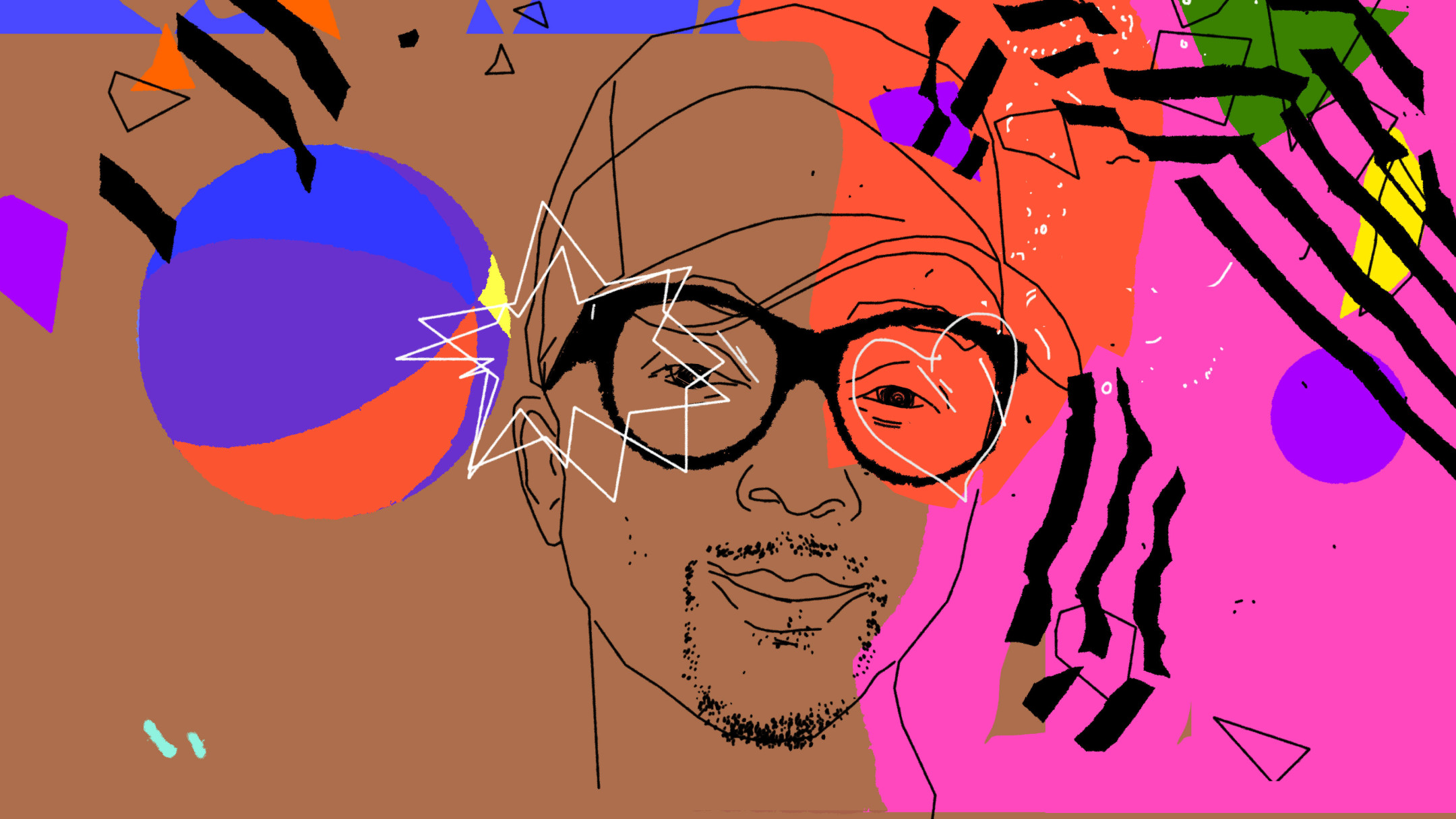In December 2020, two outer-reaching planets appeared closer together than they had in centuries. In astrology, Saturn and Jupiter are symbols of strength and order, and abundance and expansion. This Great Conjunction ushered in the age of Aquarius, the zodiac sign concerned with collectivism and pushing out the old in favor of innovation. For those devoted to astrology, this meant something new on the horizon; an opportunity for change from calcified ways of being.
While astrology is ubiquitous in defining personality, outside of its popularity there is merit in understanding why The Great Conjunction—appearing at the end of an outstanding and wretched year—mattered to people looking for something else. Some of us turn to the skies and see not a blanket of nothingness (nor an already doomed escape plan off of a burning Earth) but a way to clearly see ourselves to move forward. Certainly, this is how Jerome LaMaar—fashion designer, influencer, and creative consultant—felt this astrological movement, and how they saw their entry into the new year. LaMaar would come to relaunch their brand, 5:31, and, in a sense, reintroduce themselves.
“This is a new chapter: the way we work, the way we see ourselves, the way we collaborate and [how] we can build together,” they say to me over Zoom in their brand new, brightly lit New York apartment, a rack of clothes positioned like a fashionable rainbow in the background. LaMaar sees this astrological shift as a whole new world. “We lost our world in 2020 to [certain] changes, which we needed to get us into this new chapter.”
LaMaar, 36, is vibrant and, not to be dramatic, magical. Theirs is a transmissible happiness where one cannot help but be joyful. This energy is the core of the new 5:31. LaMaar’s dynamic designs—hoodies, jeans, a poncho—are meant for “MODERN MYSTICS, THE HARD WORKERS, THE NERDS, THE VISIONARIES,” as noted so boldly on the official shop website. Modern fashion ought not to be boring nor inaccessible. It can—and should, LaMaar believes—be everlasting.
LaMaar’s career contains multitudes. But they are a designer who has always had their name next to the celebrity wearing their creations. These achievements, worth noting always, sometimes stifle the entrepreneurial pursuit of LaMaar’s new future. When you’re asking your audience to see you as more than one thing, or one role, what will the outcome be? Boundaries between the roles and careers people occupy have increasingly shrunk or disappeared altogether as creators have emerged for any artistic practice, with ecommerce now a likely part of their journey.
LaMaar believes in timing and most of the intangible parts of living and experience that are hard to explain. Astrology is one, which plays an integral role in their brand, as LaMaar’s birthday is May 31. (A tried and true Gemini.) Energy is another. Crystals. They dream of a color-coded retail space with amethyst next to purple hoodies and rose quartz next to anything pink. The palo santo would be available next to socks.
Breaking into a smile, LaMaar says, “I think, when we present ourselves to the world, we should be able to stay authentically who we are and enjoy our lives.” It’s difficult to think LaMaar operated any other way but, of course, hard work, even manifestation they say, helped get the seasoned fashion industry insider to a place where they can authentically be themselves.
LaMaar’s fashion life is analogous to how Saturn and Jupiter interact with each other: the fashion industry, while creative, is established and often strict, but LaMaar is playful and optimistic. They are here to disrupt the current order in favor of something more specifically tuned to them, and, LaMaar hopes, others who don’t see themselves in the existing fashion world structure.

Jerome’s world
Something you should know about Jerome LaMaar is their obsession with The Wiz. The 1978 film featuring an iconic all-Black cast (Lena Horne, Diana Ross, and Richard Pryor, to name a few) reimagines The Wizard of Oz and it is a bright spectacle. A scene featuring Pryor explaining the significance of the colors orange and pink, for instance, is important to LaMaar, and something they often try to reference in their own work. “I think [of] that one scene in [the] Emerald City with The Wiz announcing what colors are next. All I've ever known is that that would be my career, my job, you know, from being a designer to being a futurist or a trend forecaster,” they say.
Where LaMaar first began, however, is fairly well known in early, and even recent, reporting on the designer: Baby Phat. The iconic 2000s brand by Kimora Lee Simmons was where it all began for the Bronx, New York native. At 15 years old, LaMaar began working with Simmons. Working their way up early on, LaMaar became a senior designer at 18. They even appeared on the reality television show Life In The Fast Lane, living through what would become the first glimpses of fame and the social media world. LaMaar later bypassed opportunities to go to Brown University and instead invested time in the Fashion Institute of Technology. Later, they worked a seven-month apprenticeship at Ralph Rucci before moving on to the Paris-based forecasting firm, Promostyl. But it was in 2013 when LaMaar launched 5:31 Jérome, a women’s fashion brand, dubbed as old-world-meets-new-world by some fashion publications.
Yet, it would be Béyonce wearing a plum-colored coat that propelled LaMaar’s career to new heights. At an Opening Ceremony launch in 2013 or 2014, LaMaar recalled meeting Béyonce’s personal stylist, Zerina Akers, who would facilitate the relationship between the two. Even Tina Knowles, Béyonce’s mother, gave LaMaar a personal shoutout when they were still a young designer. From there, that collaboration evolved into working on Ivy Park launches, the singer’s brand in partnership with adidas, and on the Disney film, Black Is King, designing a sublime seafoam blue hand-beaded Nigerian lace jumper with gloves made of turquoise, jade, mother of pearl, and Swarovski crystals.
While these résumé hits are important in shaping LaMaar’s story, their fashion world begins with and is driven by family. Having a creative family had its benefits: their grandfather was an art teacher, grandmother was a seamstress. Visual art became their first love, taking to drawing intuitively. They admit coming from a “very cool family that just understood the importance of creativity and art.” Color, too, became an important part of how LaMaar remembers and pays tribute to, especially in the new iteration of 5:31, their family. They remember their grandfather, a tall, dark-skinned Black man, wearing bold pink, pristine suits. (LaMaar says their grandfather wanted to be called the Pink Panther.)
LaMaar’s parents encouraged this vivacious child who wanted to do it all: enjoy sports with their father, and pursue art and dance classes with their mother. LaMaar’s gender fluidity, their penchant to engage in both the feminine and masculine, was tended to in this family dynamic. Also, so was an ego check: LaMaar is like a bright kite tethered by a strong string. “My family,” they say laughing, “won’t let me be a diva.”
With that, LaMaar says, came a preservation of their innocence. Family nurturing this brightness is why LaMaar designs the way they do. It has given them space to create beyond what’s possible, even carving out room for others to see themselves in LaMaar’s world in case no others fit the way they’d like. “I've used that for my career to push myself forward and create new things, and challenge people to see things completely different,” they say. “I always felt like an outcast because there was never a definition for a person like me. I started so early on in the industry when I was doing things and trying to express myself, there was no one to reference. There was no box for me to check.
“We know there's a whole array and spectrum of people who are overlooked most of the time because people don't understand how they can interact with them.”
Something LaMaar’s grandfather said to them as a small child still resonates as both a purpose and a mantra, infusing itself in their work and personal philosophy: “When I was younger, [he] would always say you were meant to be here. I used to think of the amount of the obstacles we all had to overcome to be conceived, you know, and that's very significant. There's a lottery for you to exist [and that] is very, very important.”
Manifesting magic: 5:31 reborn
Back to astrology for a moment: the Great Conjunction ushered in a universal, if subtly felt, drive for change. Even without astrological forecasting, it doesn’t take much to see and understand how systems and institutions have been changing—how people working within them are adapting, too. For LaMaar, as a designer, who is also a creative consultant, and a person consistently attached to another celebrity’s name, they felt little room to be who they wanted to be and explore that identity. LaMaar says they have loved the opportunities working with some of the most infamous among us (Beyoncé. I’m talking about Beyoncé.) and still continues to do so, even recently designing clothes worn by the artist Azealia Banks.
A more fully devoted, genderless collection is something that LaMaar insisted they manifested. And whether or not you, reader, believe in energy or magic, hard work and dedication to the craft is another way of saying something has manifested. LaMaar’s over two decades of consultancy, design, hand-sewing Swarovski crystals onto clothes, even long-lost nature-inspired design concepts, have led to this new moment.
LaMaar’s initial concept for 5:31 back in the early 2010s focused on “swinging the pendulum one direction to another, but it was very minimal,” they say, adding, “it was of course very, very basic pieces… [with] embellishments and streetwear made sexy for women only.” Now, LaMaar says, 5:31 is concerned with their own comfort and the flexibility of highly fashionable, though not entirely polished and never demure, essential pieces.
A lot of innovators are often not necessarily seen as such during their moments of genius and have a slower burn to the success of their vision. The legendarily fashionable Iris Apfel, who recently turned 100 years old, once told LaMaar that the fashion world as it exists isn’t going to catch up with them; that LaMaar’s path to carving out an audience through social media didn’t make their work any less important. “She gave me that inspiration, saying, you don't have to follow these old norms. She said, basically, do what you need to do and be happy with what you do.”
As it reads on the website, 5:31 “focuses on bridging the realms of various lifestyles, creatives, artisans, thought leaders, and design concepts through magical classics with no limitations on possibilities.” The categories for the shop are ‘gratitude’ and ‘foundations’. One has hoodies and soft sweatshirts, while the other has jeans with stretch but patches and look, when styled, like a futuristic 70s aesthetic.
The line is genderless by design with the intention, LaMaar says, to have these garments passed down and across race, gender, and age. Their goal is for these pieces to not end up in a landfill but instead become coveted and family-owned. “The idea of being here as a forecaster is pretty interesting,” LaMaar says, “Bridging the world: We have all the stuff in real life versus digital. And what's going to happen is people are just going to start sharing clothes because we don't need to shop as much. I know I shouldn’t say that but we won't need to shop as much.” In addition to a pared-down shopping life, LaMaar believes, at least for 5:31’s offerings, these are “going to be pieces that people remember and have a whole memory [with and then] pass it on. That's the vibe of this. How do you swap and share?,” LaMaar asks.
The artist as a designer, creator, and entrepreneur
There is an opportunity for influencers, creators, and anyone with any sort of public profile to pursue a path of entrepreneurship. Creativity and business, while seemingly philosophical opposites, live in harmony in this millennium. TikTok stars launching beauty brands, Instagram influencers focusing on home collections, or Twitter (and non-Twitter) famous writers launching their own Substack newsletters. If one has enough momentum with their audience, that audience now becomes a way to profit their own without any brand help. For any influencer to become or create a brand themselves, which in essence they already are because of the content they create, is a logical business step.
LaMaar is no stranger to this dynamic and welcomes it fully. Their start in social media began on MySpace when they were formerly known as The Style Monk. “The influencer thing kind of happened alongside my career.” The Style Monk even became part of LaMaar’s consultancy business. Among their current 800,000 plus followers on Instagram, people still remember them from those early online days, and it’s even how they have been writing daily reports and reviews from New York Fashion Week. The Style Monk is never far away.
But LaMaar isn’t just an influencer dabbling in the world of fashion. The industry, once a place LaMaar wanted to be as they say “a designer designer,” is where they cut their teeth in a myriad of roles from personal shopping to designing to consulting. Influencing, or content creation, or even living as an artist, runs parallel to the decades LaMaar has spent crafting their fashion designs. As an entrepreneur now, at a time when they are re-introducing themselves more broadly to potential buyers, and less exclusively with expensive, singular pieces, it’s proving to be a tough business. Self-branding can only take you so far when you’re building something new on the foundation of what was.
“I have this amazing following,” LaMaar says, but admits there isn’t a big team working behind the scenes. “The different hats that I must wear, the meetings I have to take. It's a very small team and we're doing our best to make sure it's professional, creative, and interesting for the public. Every day I'm learning how to run this business, whether it's me building content, which I am going to start doing, which is what the brand [is] all about: teaching people how to dress. How do you teach people how to dress? Well, I now have some videos [teaching] people how to wear different pieces.”

5:31 has largely been showcased on LaMaar on Instagram and their other channels in this effort to present how these pieces can be styled for everyday (or every party day) life. Instead of tapping celebrities and other influencers, wearing and being the brand is exactly how LaMaar, and many others in their position, leverage interest. For LaMaar, that was intentional. “I deliberately not I did not partner with any celebrity for this launch. I didn't send them anything. I didn't do any influencer drops or anything yet because I wanted to gauge the conversation without attaching my life and my universe to a celebrity.”
LaMaar’s gratitude for and continued work with other celebrities is clear. Yet, as they say, they are on a new journey of public discovery. Who will Jerome LaMaar and 5:31 be to both their social media following or anyone interested in fashion? “Although I do contribute to amazing projects from all these amazing celebrity brands or lifestyles, [my followers] like me for this lifestyle. And that is why the brand needed to exist now because I wanted to show people that this is me now,” they say. “I'm not the guy who is running around with celebrities all the time. I'm just the guy who's working in my studio with my head down. I want the brand to represent the hard workers.”
We’re nearly a year into the Age of Aquarius—that existential pivot since The Great Conjunction. Is the fashion world ready for the change LaMaar is bringing to the surface? Amid all of the sometimes ardent struggles of launching a new business, and a new self, LaMaar sees the beauty of it all. The celebration. Which is what 5:31 ultimately is.
“I want [buyers] to feel the celebration they can be working for. You can feel the energy. You can feel like, ‘I am wearing something that feels like a celebration.’”






